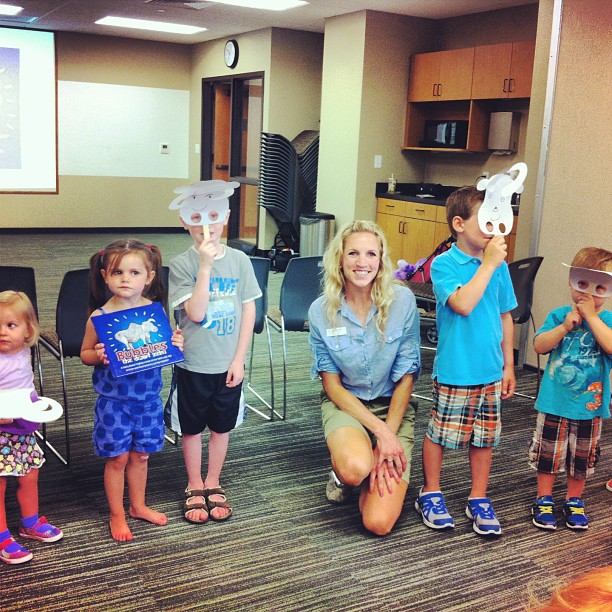The summer school kids of Eugene Field Elementary School recently emailed me a (very fun!) list of questions about animals and the Zoo.
When I worked in Guest Services, the only question visitors ever asked me was, “where’s the closest bathroom?”.
Now that I’m in Carnivore, I usually get “where the bears at?”.
A tip of the hat to Eugene Field’s students. These questions are much, much better.
What made you decide to write a book about Bubbles?
I wanted to write a book about an animal in our Children’s Zoo. I thought that Bubbles would make a cute story because of her real life friendship with Xavier, the goat. My boss at the Zoo agreed!
How does the female of animals get pregnant to have baby snakes?
It is very similar to how mammals reproduce! The male snake inserts in organ (called a hemipenis) into an opening in the female (called a cloaca) and the female’s eggs are fertilized with the male’s reproductive cells. Some snakes give birth to live babies (called viviparous) while others lay eggs (called oviparous).
How do you know when an animal is pregnant?
At the Zoo, if we think an animal may be pregnant we closely monitor the levels of her Progesterone hormones. These hormones tell us if the animal is pregnant and how close to delivery she is. We can also observe the animal’s size and behavior for clues. That being said, sometimes even at the Zoo we do have a few surprises! This baby Anteater Sabia was a BIG surprise! http://www.youtube.com/watch?v=sx_E10KLM_k
What other unique animals are at the zoo?
We have over 18,000 animals at the St. Louis Zoo! All are VERY unique. From the burying beetle who lays its eggs into other animals poop or the sheltopusik (a legless lizard!) you can find crazy animals all over the Zoo. One of my favorite unique animals is the Naked Mole Rat. People always think they are babies but ours in St. Louis are 12 years old and they can live to almost 25!
How many animals eat their own poop?
It is pretty common for animals to eat their own poop. You may have even seen your dog or cat do it! Why? Well, poop is nothing but digested food stuff and sometimes animals don’t want to waste any potential nutrients….let’s just say it happens.
How long have you been a zookeeper?
I have been a Zookeeper for four years.
Have you ever heard of weird animal names?
Of course! Sometimes normal names sound weird for an animal. Our lion girl, Imani, has a new mate named John. John just doesn’t seem to fit a lion! Our Naked Mole Rats are named Snausages, Oscar, Meyer and Mr. Teeth to name a few. The addax all have “ella” names i.e. Portabella, Nutella, Mirabella, Cinderella etc. We had a guinea pig named Oops. Usually keepers make up the names, so, yes, sometimes they are weird.
Why did you take pictures of poop?
I didn’t! I googled those pictures. But if anyone wants to grow up to be a Zookeeper it is certainly important to know how to identify different types of poop!
How many animals play with their own poop?
Most animals are fairly clean and don’t like to walk through or play with their own poop. Many poop in one area and do not go into that area for any other reason. Pigs, for example, are very clean with their bathroom habits. Apes, however, are well known to play with their own poop, even throwing it at people they don’t like very much!
What education/schooling/training is needed to be a zookeeper?
Most Zookeepers have a Bachelor’s Degree in either Biology, Zoology or Animal Science. Some have Masters degrees. The field is becoming more competitive, so in the last 10-15 years a degree has certainly been a requirement. I was very lucky because I got this job with a Creative Writing degree. Many Zoos also look for prior animal care experience (i.e. volunteer work at a Zoo/humane society/barn etc)
How many animals are there at the zoo?
There are over 18,000 individual animals at the Saint Louis Zoo! Though these include ALL of the insects in the insectarium and our many, many newly hatched endangered hellbenders.
How long has the St. Louis Zoo been open?
The Saint Louis Zoo has been open for 103 years. Since 1910!
What is your favorite animal at the zoo?
Such a hard question. I’ll give you my top five.
1. Gilbert the Macaw I trained in the Children’s Zoo.
2. Daisy the Sloth Bear
3. Mtai and Serafina the lion cubs
4. Hannah the Children’s Zoo dog who I got to take home with me last summer.
5. The entire elephant herd (they are such a cool family!)
How much can an elephant weigh?
African elephants are the larger of the species (we have Asian at the STL Zoo) and males can be up to 12,000 pounds, females 8,000-11,000. Baby elephants are born around 200-300 pounds. Raja is our biggest elephant in St. Louis and he is around 10,000 pounds.
How long have you had Jake the snake?
I have had Jake the snake for about a year. He has travelled thousands of miles around Missouri visiting schools like yours! He loves his road trips!
What is the most aggressive animal at the zoo?
The most aggressive/dangerous animal is probably Tazon the black jaguar. He is an old man (he just turned 20) but jaguars are pound for pound the strongest big cat in the world and let’s just say Tazon is quite the predator.
How much can an elephant drink in one day?
A lot! They can suck up about 15 liters in their trunk in one go. They generally consume about 100 liters of water a day.













